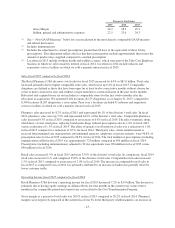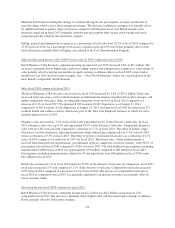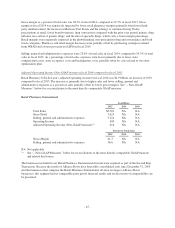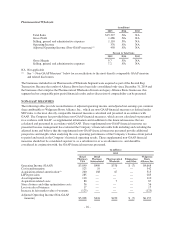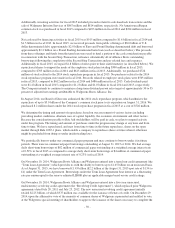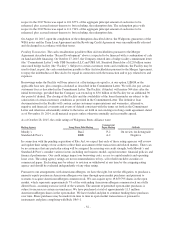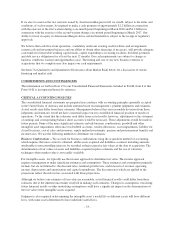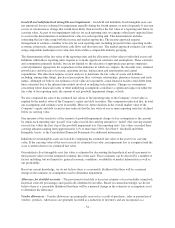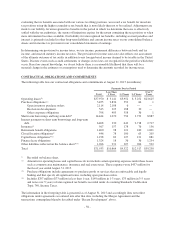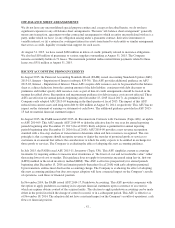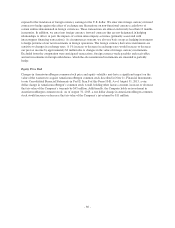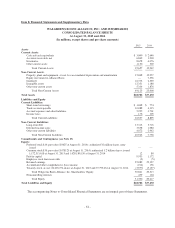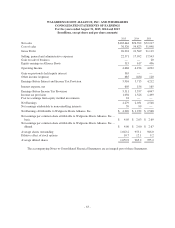Walgreens 2015 Annual Report Download - page 57
Download and view the complete annual report
Please find page 57 of the 2015 Walgreens annual report below. You can navigate through the pages in the report by either clicking on the pages listed below, or by using the keyword search tool below to find specific information within the annual report.
If we elect to exercise the two warrants issued by AmerisourceBergen in full, we would, subject to the terms and
conditions of such warrants, be required to make a cash payment of approximately $1.2 billion in connection
with the exercise of the first warrant during a six-month period beginning in March 2016 and $1.2 billion in
connection with the exercise of the second warrant during a six-month period beginning in March 2017. Our
ability to invest in equity in AmerisourceBergen above certain thresholds is subject to the receipt of regulatory
approvals.
We believe that cash flow from operations, availability under our existing credit facilities and arrangements,
current cash and investment balances and our ability to obtain other financing, if necessary, will provide adequate
cash funds for foreseeable working capital needs, capital expenditures at existing facilities, dividend payments
and debt service obligations for at least the next 12 months. Our cash requirements are subject to change as
business conditions warrant and opportunities arise. The timing and size of any new business ventures or
acquisitions that we complete may also impact our cash requirements.
See Item 7A (Qualitative and Quantitative Disclosures about Market Risk) below for a discussion of certain
financing and market risks.
COMMITMENTS AND CONTINGENCIES
The information set forth in Note 13 to our Consolidated Financial Statements included in Part II, Item 8 of this
Form 10-K is incorporated herein by reference.
CRITICAL ACCOUNTING POLICIES
The consolidated financial statements are prepared in accordance with accounting principles generally accepted
in the United States of America and include amounts based on management’s prudent judgments and estimates.
Actual results may differ from these estimates. Management believes that any reasonable deviation from those
judgments and estimates would not have a material impact on our consolidated financial position or results of
operations. To the extent that the estimates used differ from actual results, however, adjustments to the statement
of earnings and corresponding balance sheet accounts would be necessary. These adjustments would be made in
future periods. Some of the more significant estimates include business combinations, goodwill and other
intangible asset impairment, allowance for doubtful accounts, vendor allowances, asset impairments, liability for
closed locations, cost of sales and inventory, equity method investments, pension and postretirement benefits and
income taxes. We use the following methods to determine our estimates:
Business Combinations –We account for business combinations using the acquisition method of accounting,
which requires that once control is obtained, all the assets acquired and liabilities assumed, including amounts
attributable to noncontrolling interests, be recorded at their respective fair values at the date of acquisition. The
determination of fair values of assets and liabilities acquired requires estimates and the use of valuation
techniques when market value is not readily available.
For intangible assets, we typically use the income approach to determine fair value. The income approach
requires management to make significant estimates and assumptions. These estimates and assumptions primarily
include, but are not limited to: the discount rates; terminal growth rates; and forecasts of revenue, operating
income, depreciation and amortization and capital expenditures. The discount rates which are applied to the
projections reflect the risk factors associated with those projections.
Although we believe our estimates of fair value are reasonable, actual financial results could differ from those
estimates due to the inherent uncertainty involved in making such estimates. Changes in assumptions concerning
future financial results or other underlying assumptions could have a significant impact on the determination of
the fair value of the intangible assets acquired.
Judgment is also required in determining the intangible asset’s useful life as different assets will have different
lives, with some assets determined to have indefinite useful lives.
-53-


